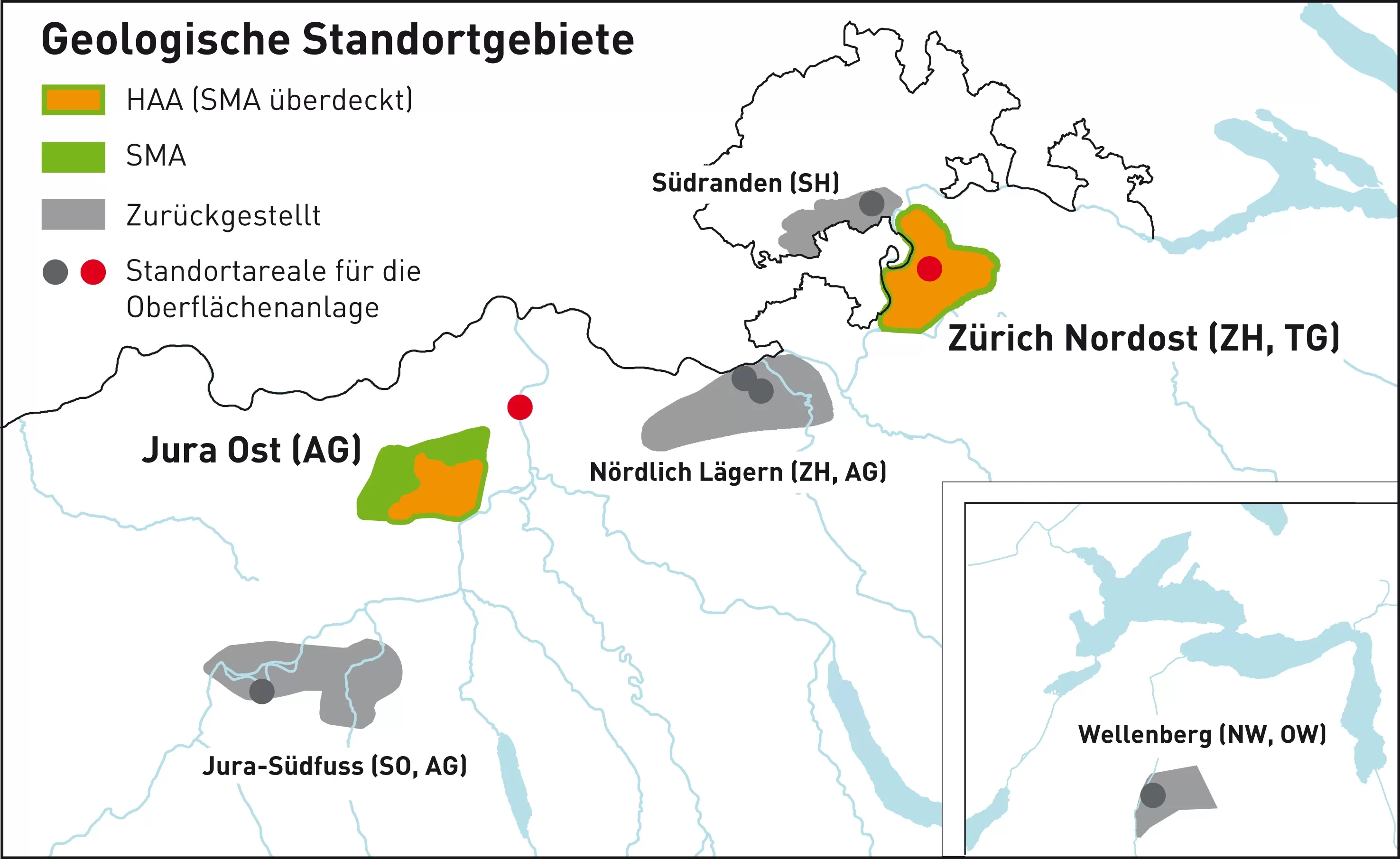Site selection: Nagra proposes the geological siting regions Zürich Nordost and Jura Ost
At a media conference hosted today by the Swiss Federal Office of Energy (SFOE), Nagra presented its proposals for the geological siting regions for further investigation in Stage 3 of the Sectoral Plan for Deep Geological Repositories. The proposed siting regions are Zürich Nordost and Jura Ost. The regions Südranden, Nördlich Lägern, Jura-Südfuss and Wellenberg will be placed in reserve. These proposals represent the result of the safety-based comparison of the siting regions carried out by Nagra in line with the requirements specified by the Swiss Federal Nuclear Safety Inspectorate (ENSI).
Nagra is required by federal guidelines to make siting proposals that will provide the basis for the decision to be made by the Federal Council – expected for 2017 – on Stage 2 of the Sectoral Plan process. Of the six geological siting regions that were adopted into the Sectoral Plan process with the decision of the Federal Council on Stage 1 in November 2011, Nagra has to propose at least two regions each for a high-level waste (HLW) repository and a low- and intermediate-level waste (L/ILW) repository for further investigation in Stage 3 of the process. For this purpose, Nagra carried out a safety-based comparison of the siting regions in line with the requirements specified by ENSI. Geological siting regions can only be placed in reserve if they show clear disadvantages in terms of safety compared with the other regions, as evidenced by geological investigations carried out to date.
Thomas Ernst, Nagra’s Chief Executive Officer, explained that the safety-based comparison has confirmed that all six geological siting regions fulfil the strict safety requirements specified at a federal level and are therefore suitable for the construction of deep geological repositories. However, a detailed comparison of the siting regions reveals decisive differences. Nagra therefore proposes that the siting regions Zürich Nordost and Jura Ost be the subject of further investigations in Stage 3 and that the regions Südranden, Nördlich Lägern, Jura-Südfuss and Wellenberg be placed in reserve. Dr. Ernst further explained that Zürich Nordost and Jura Ost best fulfil the safety requirements for both a high-level waste and a low- and intermediate-level waste repository. The investigations have shown that the impermeable rock formations that provide safe containment of the waste occur at an optimum depth in these regions; they are protected against erosion, are stable on the long-term and are sufficiently large. The most important criterion for decision-making in the context of site comparison is long-term safety. The siting regions were evaluated and compared in a stepwise process, taking into consideration only scientific and technical criteria; societal and political aspects are not relevant in this respect.
Nagra’s siting proposals were submitted to the SFOE on 30th December 2014 and are currently being reviewed by ENSI.
-
Enclosure
Overview map showing the siting regions
-
Technischer Bericht NTB 14-01
«Sicherheitstechnischer Vergleich und Vorschlag der in der Etappe 3 weiter zu untersuchenden geologischen Standortgebiete»; Dezember 2014 – Textband
-
Technischer Bericht NTB 14-01
«Sicherheitstechnischer Vergleich und Vorschlag der in der Etappe 3 weiter zu untersuchenden geologischen Standortgebiete»; Dezember 2014 – Anhang
-
Themenheft
«Standortgebiete für geologische Tiefenlager – Sicherheitstechnischer Vergleich: Vorschläge für Etappe 3»; Januar 2015
-
Faltblatt
«Standortgebiete für geologische Tiefenlager – Erdwissenschaftliche Untersuchungen für Etappe 3»; Januar 2015
Karte mit den geologischen Standortgebieten.

According to Swiss nuclear energy legislation, the producers of radioactive waste are responsible for its safe management and disposal. In 1972, the nuclear power plant operators and the Federal Government set up the National Cooperative for the Disposal of Radioactive Waste (Nagra) to perform this task. Nagra, which has its headquarters in Wettingen (AG), is the national technical competence centre in the field of deep geological disposal of radioactive waste.
Out of a strong sense of responsibility for the long-term protection of man and the environment, 100 employees are involved daily in performing this important work. The high level of competence is secured by targeted research programmes in two Swiss underground rock laboratories and intensive international collaboration.